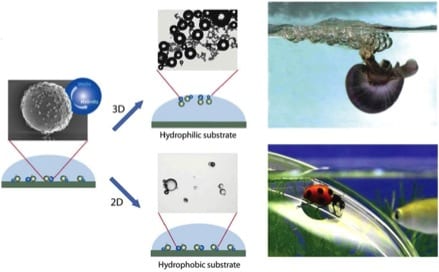Natural bubbles are used by small animals such as ladybirds, leaf beetles, and purple snails for vital activities underwater. In nature, biological surfaces can be naturally hydrophobic, for example beetle legs, with multi-level structures to entrap air, or naturally hydrophilic – snail mucus- in which particle-bubble complexes escape from the surface and accumulate at the air-water interface due to buoyancy. These hydrophilic-hydrophobic interactions and capillary forces are used as powerful tools for locomotion and stabilization at solid-liquid and air-liquid interfaces. These systems, therefore, have come to the attention of researchers, who are looking forartifical means to reproduce them.

Dr. Bat-El Pinchasik, at Department of Interfaces, Max Planck Institute for Colloids and Interfaces, has now presented, along with co-workers, interesting work on this subject. They report that the propulsion of synthetic Janus particles seems to be similar to physical phenomena present in biological bubble system. In their work, an easy, general and versatile method to produce Janus particles is presented with an emphasis on modification of particles by water-based reactions or adsorption of particles from aqueous suspensions. In the study, bubbles are used to propel and control the location of Janus particles in an aqueous medium. Janus particles such as SiO2–Ag (with a diameter of 4.8 mm) and polystyrene-Ag (PS-Ag) (with a diameter of 10 mm) can be synthetized through embedment in Parafilm. The Janus particles, partially covered with catalytically active Ag nanoparticles, are redispersed in water and placed on a glass substrate. The active Ag sites are used for the splitting of H2O2 into water and oxygen. In this case, an oxygen bubble is formed on one side of the particle and promotes its propulsion. The stable bubble-particle complex can be manipulated by tuning hydrophilic-hydrophobic interactions with the surface. A transition between two- and three-dimensional behaviors of particles appears as changing the hydrophobicity of the substrate. It implies a developing ability to control characteristics of interface and particle in dynamic wettability.
This bubble-generating system opens potential applications in manipulation and guidance of particles at water/solid interfaces inside fluidic devices, and particle-bubble complexes in the presence of surfactants and for water purification. It would be interesting to modulate the interfacial adhesion to alter the nucleation of bubbles and the propulsion of particle-bubble complexes. The synthesis method of the Janus particles can be potentially used for other particle geometries and is complimentary to embedding and patterning of particles and capsules in biocompatible films, where the degree of patterning can be controlled by gold nanoparticles adsorbed on such films.

















